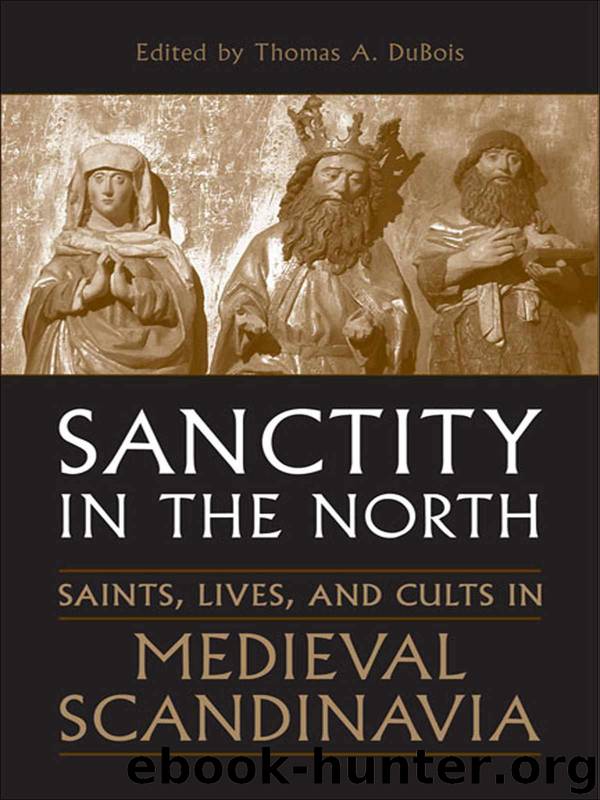Sanctity in the North: Saints, Lives, and Cults in Medieval Scandinavia (Toronto Old Norse-Icelandic Series (TONIS)) by DuBois Thomas

Author:DuBois, Thomas [DuBois, Thomas]
Language: eng
Format: mobi, epub
Tags: HIS044000
Publisher: University of Toronto Press
Published: 2008-02-22T16:00:00+00:00
A Struggle of Dynasties
Eric Jedvardsson’s death occurred in a very unstable period for the Swedish monarchy. The two dynasties that had apparently ruled Sweden at least since the introduction of Christianity (the Uppsala dynasty and the Stenkil dynasty) had died out, and in their place, two factions of (according to tradition) aristocratic, but not royal, descent contended for power. Later historians refer to each of these groups by the names of their putative founders: the Sverker dynasty (or party) and the Eric dynasty. Sverker the elder, who was closely allied by marriage with Danish and Norwegian royalty, appears to have come to the throne around 1130, and to have reigned until some time in the 1150s. He was followed not by his son Karl (who instead ruled c. 1161–7), but by Eric Jedvardsson, who was thus the founder of the Eric dynasty (Westman 1954, 1–23). In fact, the Swedish throne would be held alternately by members of the Sverker and Eric dynasties in turn for over a century.
There can be no doubt that a saintly ancestor is just the thing to legitimize a royal dynasty. For example, by the time of Eric Jedvardsson’s death in battle, several members of the various branches of Denmark’s contentious royal family had been promoted as saints. Indeed, two of them, St Knud, (one of the many sons of Svend Estridsen) who died in 1086, and his nephew Knud Lavard (d. 1131) actually received papal recognition, and were canonized at the behest of the relatives who had most to gain by promoting their cults. The cult of St Knud was promoted most strongly by his brother, King Erik Ejegod, who succeeded in bringing about Knud’s canonization by 1101. In the generations that followed, the cult of Knud Lavard was promoted first by the saint’s brother, King Erik Emune, and later by Erik’s son, (King) Svend Grathe, and Knud’s own son King Valdemar. Through Valdemar’s efforts, St Knud Lavard was recognized by Pope Alexander III in 1169 (Westman 1954, 7, Nilsson 1998, 29). These circumstances were hardly unknown in Sweden at the time of Eric Jedvardsson’s death. It seems more than likely that the earliest initiative for a cult of St Eric in Sweden came from the slain king’s son, Knut Ericsson, who came to the throne of Sweden in 1167. Carlsson (1944) is convinced that Eric Jedvardsson’s remains were translated before 1196, the year that Knut Ericsson died and was succeeded on the throne by Sverker Karlsson. Certainly no member of the Sverker dynasty would have any interest in promoting the veneration of a rival (Carlsson 1944, 105). Interestingly, an inspection of the relics in the shrine of St Eric, carried out in 1946, revealed information that could support Carlsson’s hypothesis. The examination of the bones in the reliquary showed them (with the exception of one bone belonging to another individual) to be the remains of an apparently healthy male in his forties. Many of the bones showed damage, clearly sustained just before or just after death, that was consistent with the description of the saint’s martyrdom.
Download
Sanctity in the North: Saints, Lives, and Cults in Medieval Scandinavia (Toronto Old Norse-Icelandic Series (TONIS)) by DuBois Thomas.epub
This site does not store any files on its server. We only index and link to content provided by other sites. Please contact the content providers to delete copyright contents if any and email us, we'll remove relevant links or contents immediately.
| Ancient & Classical | Arthurian Romance |
| Beat Generation | Feminist |
| Gothic & Romantic | LGBT |
| Medieval | Modern |
| Modernism | Postmodernism |
| Renaissance | Shakespeare |
| Surrealism | Victorian |
4 3 2 1: A Novel by Paul Auster(12281)
The handmaid's tale by Margaret Atwood(7678)
Giovanni's Room by James Baldwin(7189)
Asking the Right Questions: A Guide to Critical Thinking by M. Neil Browne & Stuart M. Keeley(5632)
Big Magic: Creative Living Beyond Fear by Elizabeth Gilbert(5610)
Ego Is the Enemy by Ryan Holiday(5293)
The Body: A Guide for Occupants by Bill Bryson(4974)
On Writing A Memoir of the Craft by Stephen King(4863)
Ken Follett - World without end by Ken Follett(4644)
Adulting by Kelly Williams Brown(4486)
Bluets by Maggie Nelson(4472)
Eat That Frog! by Brian Tracy(4432)
Guilty Pleasures by Laurell K Hamilton(4358)
The Poetry of Pablo Neruda by Pablo Neruda(4038)
Alive: The Story of the Andes Survivors by Piers Paul Read(3967)
White Noise - A Novel by Don DeLillo(3953)
Fingerprints of the Gods by Graham Hancock(3940)
The Book of Joy by Dalai Lama(3899)
The Bookshop by Penelope Fitzgerald(3775)
